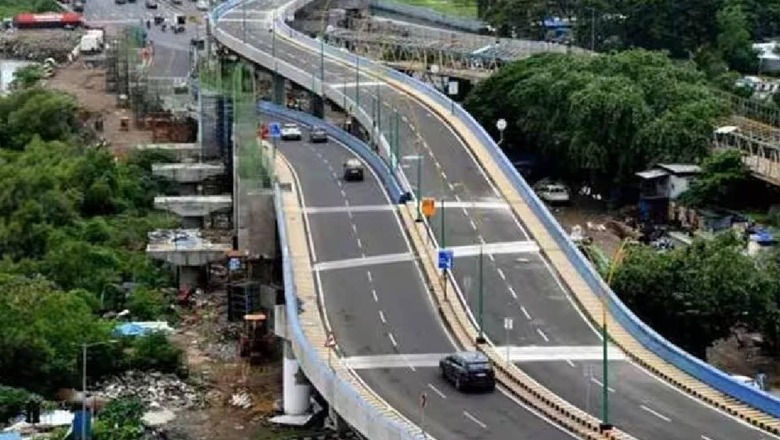
views
India’s infrastructure push in the past decade has been phenomenal. But now plans are afoot to take it a step further with a project to construct and expand a staggering 41,000 kilometres of national highways, including the development of 15,000 kilometres of high-speed corridors, by FY32.
The ambitious plan is likely to cost around Rs 20 lakh crore and will unfold in phases starting FY29. Once realised, this extensive road network is poised to nearly double the average travel speed on national highways—from the existing 47 kmph to an impressive 85 kmph.
Progress since 2014: Building for success
India has elevated infrastructure as a core pillar of its developmental agenda, with roads emerging as a linchpin for connectivity—a crucial determinant of prosperity. India’s national highway network has expanded from approximately 91,287 km in March 2014 to about 1,46,145 km—a monumental 59% addition to the pre-2014 network of approximately 66,000 kilometres built since Independence.
Key achievements include the transformative Delhi-Mumbai Expressway, slashing travel time by half, and the expansion of vital ports-to-hinterland corridors. Projects like the Delhi-Meerut Expressway and the Mumbai Trans-Harbour Link (MTHL) have alleviated major traffic bottlenecks. The eagerly awaited MTHL, with a length of 23 kilometres, consists of a six-lane, 21.8-km road bridge connecting Sewri in Mumbai to Chirle in Navi Mumbai. Upon completion, this project is expected to provide a crucial link between south Mumbai and the thriving Navi Mumbai township.
A substantial increase in the budgetary allocation initiated the surge in growth, skyrocketing from Rs 31,130 crore in 2013-14 to an impressive Rs. 2,70,435 crore in 2023-24, which also encompassed a notable rise in capital expenditure on national highways, from Rs 51,000 crore in 2013-14 to Rs 2,40,000 crore in 2022-23.
Throughout this period, the country has accelerated the pace of highway construction to 36 km per day, with aspirations to further elevate it to 40 km per day.
The past decade has witnessed a remarkable expansion of the four-lane plus national highway network. This includes high-speed corridors that have experienced exponential growth from 18,371 km in March 2014 to an extensive 46,179 km at present. Simultaneously, the government has reduced the length of two-lane national highways from around 27,517 km in March 2014 to approximately 14,870 km, constituting merely about 10% of the total network.
Strategic roads in border regions such as Ladakh, Arunachal Pradesh, and Assam have enhanced military mobilisation along the Line of Actual Control (LAC), Line of Control (LoC), and the India-Myanmar frontier.
Despite initial delays, the incorporation of new technologies and institutional reforms has bolstered execution on an unprecedented scale. National Highways Authority of India’s Infrastructure Quality Index (IRI) reports that the quality of roads meets 88% of optimal standards nationally. Widening and elevated corridors have increased average annual daily traffic (AADT) on critical routes, such as NH34, 5, 7, and 19, by 30% in just five years.
2024: A primer for the future
Ongoing projects, valued at a staggering Rs 5.35 lakh crore under the 2023-24 timeline, promise to densify the highway network further, positioning it as a potent catalyst for the next phase of development.
Upcoming projects by 2024 aim to connect major consumption and production centres through the 3,300-kilometre Golden Quadrilateral, and its diagonals will play a pivotal role in facilitating the smooth movement of goods and services.
Strategic initiatives, such as the Chardham project and the ongoing development of the Arunachal Frontier Highway aim to better integrate remote frontier areas. Flagship expressways are undergoing expedited development, as seen in the case of the Delhi-Katra corridor, which not only enhances facilities for the Amarnath Yatra but also stimulates industries along its route.
By March 2024, the government has also announced plans to implement new GPS-based toll collection systems to replace the existing highway toll plazas. This initiative aims to alleviate traffic congestion and enable precise toll charges based on the actual distance travelled on highways. Two pilot projects using automatic number plate recognition systems (ANPR cameras) to facilitate automated toll collection have already been conducted.
In the fiscal year 2018-19, vehicles experienced an average waiting time of eight minutes at toll plazas. The introduction of FASTags in 2020-21 and 2021-22 significantly reduced this waiting time to just 47 seconds. This could be reduced further with GPS-based toll collection systems.
The transport ministry also intends to auction road and highway projects exceeding Rs 2 lakh crore on the build-operate-transfer (BOT) model by March 2024. The focus is now on encouraging private participation in the construction of high-quality roads, with a stipulation for the responsible entities to ensure maintenance for 15 years. Union transport minister Nitin Gadkari has also emphasised a preference for the Infrastructure Investment Trusts (InvITs) for future highway construction projects. InvITs are financial instruments designed to pool funds from investors. This will replace the current toll-operate-transfer model.
Strengthening connectivity to Bangladesh, Myanmar, and Nepal through border trade routes is another focal point for 2024. These have been prioritised under the Bangladesh-Bhutan-India-Nepal Economic Corridor, which could transform trade and development in north-east and east India. The long-term vision envisages a comprehensive pan-India network.
Economic and security impact: A dual triumph
India’s highway revolution has been an economic boon, creating hundreds of thousands of direct jobs and expanding market access to more than 670 districts. Projects like the Mumbai-Bengaluru Expressway have not only spurred manufacturing but have also fueled a 30% growth in trade with seaports since 2018.
The upgraded transport infrastructure is projected to boost the GDP by 0.5-1% by 2024 as industries announce expansions. Enhanced road logistics have optimised inventory and lowered production costs across sectors, fostering growth from cement to automobiles. Regional communities now have greater opportunities through improved access to expanding agricultural and business markets on both national and global scales.
The proposed increase in average speed on highways and reduced logistics costs, targeted to be 9-10% of the GDP by 2030, underline the government’s commitment to fostering economic efficiency.
Strategically planned roads enhance the capabilities of border management. The utilisation of models like DS-DBO, particularly in challenging projects such as the Sela Tunnel, has proven instrumental in swiftly concluding border infrastructure development.
The reinforcement and modernisation of integrated checkposts, equipped with improved facilities for continuous patrolling and surveillance, signify significant advancements. According to defence analysts, expedited troop mobilisation has significantly contributed to the heightened preparedness levels of the armed forces during recent tense standoffs.
Regular movement along border roads fosters increased awareness among remote populations. The expanded network now ensures continuous monitoring in sensitive areas through the fortification of security-grade roads.
Environmental considerations: A sustainable approach
A thorough assessment of environmental risks is undertaken throughout the planning and implementation phases of the projects. Independent auditors have reported the successful restoration of more than 15,000 hectares of degraded land through afforestation initiatives near construction zones. During the construction of the Dwarka Expressway, at least 1,200 trees were re-transplanted, another first for India.
Rigorous enforcement of stringent emission standards is evident, with over 60% of highways exclusively allowing BS-VI-grade vehicles.
The preservation of habitat connectivity is supported by robust wildlife underpasses, flyovers, and fencing systems, with state forest reports indicating an increase in forest animal populations. Advocacy campaigns have underscored the importance of modal shifts in cargo transportation on key routes, aiming to mitigate long-term hazardous vehicular emissions.
Challenges
Despite significant advancements, the construction and expansion of national highways in India do face numerous challenges:
Decrease in New Construction Projects- Although the construction of new national highways saw a 10% increase in the current fiscal, there was also a 52% decline in the allocation of new construction projects. This after the finance ministry asked the roads ministry to get cabinet approval for allocation under the Bharatmala project. This could potentially hinder the government’s goal of constructing approximately 12,000 km of highways in FY25.
There has been a slowdown in the bidding process for new projects, with a significant decrease in the kilometres of work bid for compared to the previous year. Last year, agencies bid for 5,382 km of work between April and November, whereas this year, the figure has only reached 2,815 km. Some of these delays have been due to state elections. However, just a week ago, the NHAI finally managed to award TOT projects worth Rs 9,384 crore.
NHAI’s Debt- NHAI’s cumulative debt has also been piling up. It has gone up 14 times since 2014-15 to stand at Rs 3.4 lakh crore as of September 2023. However, the proposed Infrastructure Investment Trusts or InvITs are expected to help pare some of these debts in the long run.
Rising Road Accidents- Despite the expansion of the highway network, India faces a severe road safety crisis with a significant number of road accidents and fatalities, particularly on national and state highways. Significantly, India has had to push back its road safety targets to 2030. The transport ministry has implemented various strategies focusing on education, engineering, enforcement, and emergency care to tackle safety issues. However, many of these road safety challenges will require long-term strategic planning and awareness.
Environmental Considerations- While there have been successes in environmental sustainability, such as the restoration of degraded land and the transplantation of trees during the Dwarka Expressway construction, challenges remain in maintaining standards consistently across all projects. Independent auditors have reported the successful restoration of more than 15,000 hectares of degraded land through afforestation. Rigorous enforcement of emission standards has also helped, with over 60% of highways exclusively allowing only BS-VI-grade vehicles now.
A vision unfolds
A resilient and expansive highway network stands as a linchpin in India’s ambitious pursuit of achieving developed nation status. The significance of a robust infrastructure, particularly in the form of a well-connected and efficient highway network, is paramount in shaping the trajectory of India’s developmental aspirations.
According to official statements, India’s road and highway infrastructure has reportedly exceeded that of China, and by the end of 2024, it is expected to rival or even surpass that of the United States. This achievement marks a significant transformation.
This fundamental infrastructure backbone not only facilitates seamless connectivity but also plays a pivotal role in fostering economic growth, regional development, and overall national progress. In examining India’s path towards becoming a developed nation, the emphasis on building and enhancing its highway network emerges as a strategic imperative.
With the bulk of implementation challenges addressed, India’s strategic highway network transformation stands as an unprecedented feat in scale and impact. If the renewed focus, multi-faceted vision, and alignment with sustainability continue, this national mission has the potential to be a harbinger of equitable, eco-friendly, and secure progress on the world stage.

















Comments
0 comment